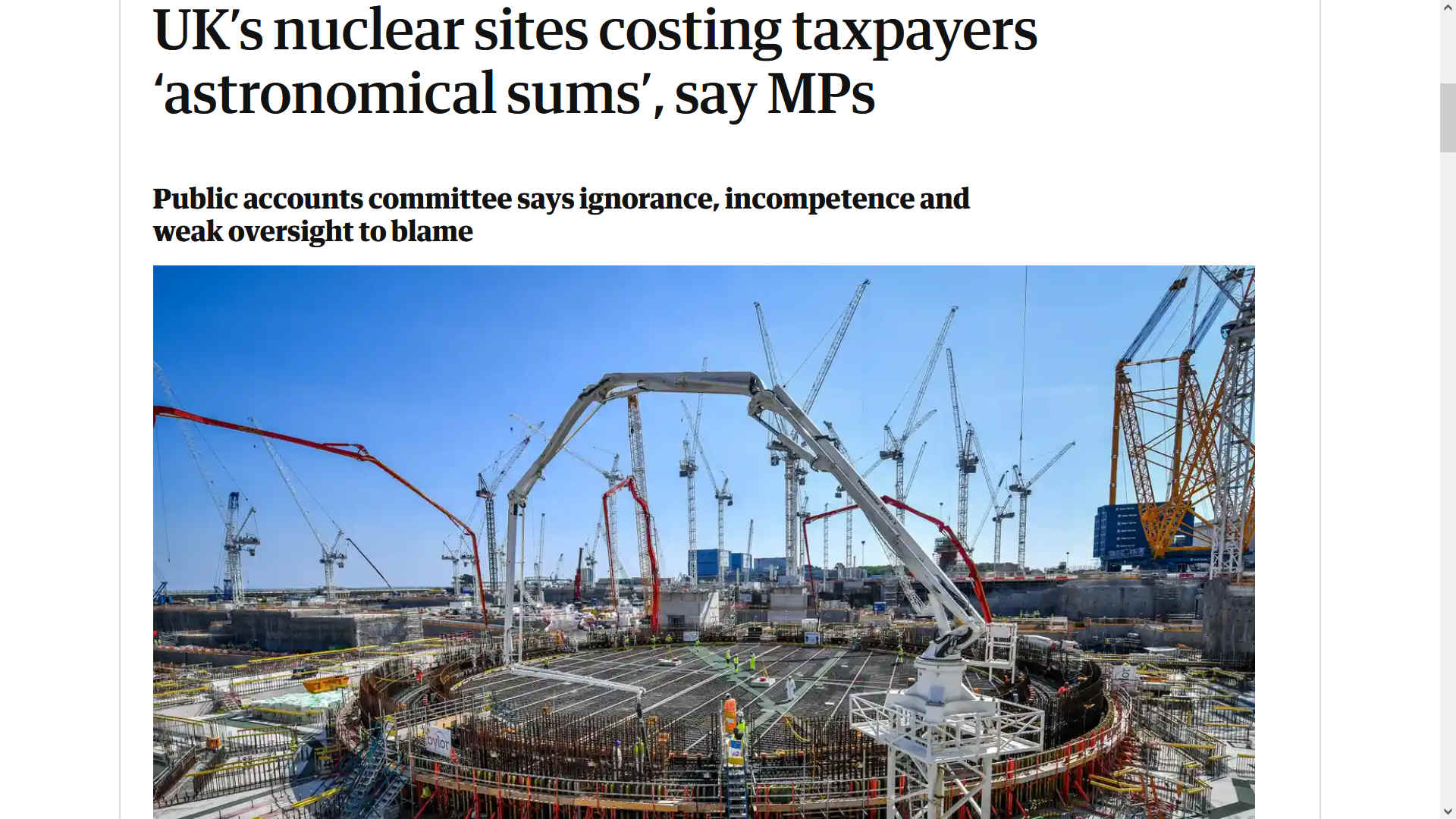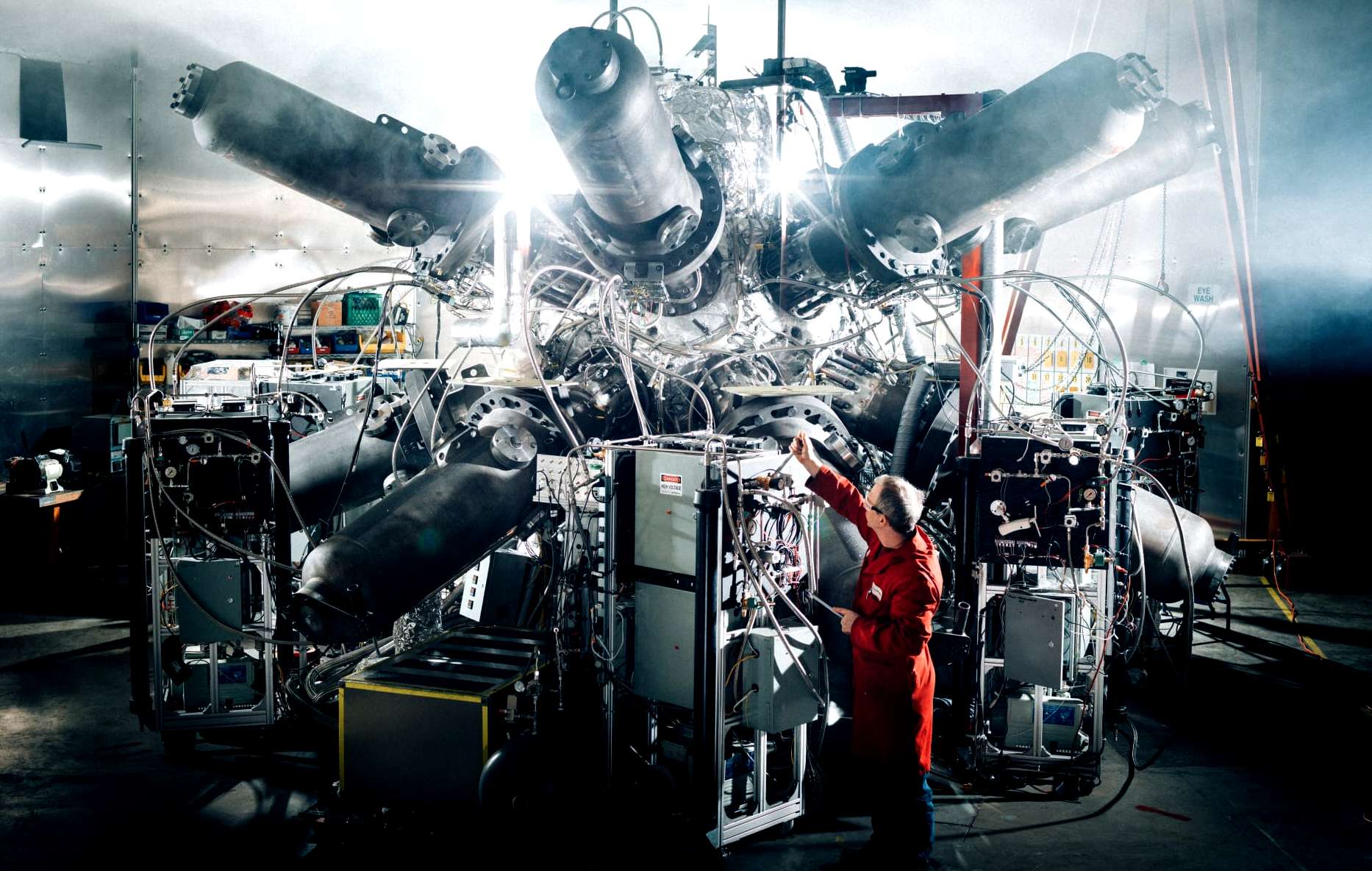|

POWER
HUNGRY -
Although some countries act as though there is no energy crisis, in fact
they have departments for such matters, that are there to advise for how
much longer they can abuse their positions in world politics, to take
advantage of other countries and keep on killing species and warming the
planet - before their kleptocratic
inclinations are compromised.
THE GUARDIAN 27 NOVEMBER 2020
- UK’s nuclear sites costing taxpayers ‘astronomical sums’, say MPs - Public accounts committee says ignorance, incompetence and weak oversight to blame
The Nuclear Decommissioning Authority (NDA) has a perpetual lack of knowledge about the state and location of waste on the 17 sites it is responsible for making safe, a powerful committee of MPs has found.
This results from decades of poor record keeping and weak government oversight, the MPs said. Combined with a “sorry saga” of incompetence and failure, this has left taxpayers footing the bill for “astronomical sums”, they said.
The NDA acknowledges that it still does not have full understanding of the condition of its sites, including 10 closed Magnox stations from Dungeness in Kent to Hunterston in Ayrshire, the MPs report said.
The NDA’s most recent estimate is that it will cost current and future generations of UK taxpayers £132bn to decommission the
civil nuclear
sites, with the work not being completed for another 120 years.
Since 2017, the NDA’s upper estimate of the cost of the 12-15-year programme just to get the sites to the ”‘care and maintenance” stage of the decommissioning process has increased by £3.1bn to £8.7bn. “Our past experience suggests these costs may increase further,” said the MPs’ report.
The lack of knowledge of the sites was a significant factor in the failure of a 2014 contract the NDA signed with a private sector company to decommission the Magnox sites. The government was forced to take back the contract in 2018 and the botched tender has now cost taxpayers £140m, the MPs found.
Sir Geoffrey Clifton-Brown, deputy chair of the public accounts committee (PAC), said: “Although progress has been made since our [2018] report, incredibly, the NDA still doesn’t know even where we’re currently at, in terms of the state and safety of the UK’s disused nuclear sites. Without that, and after the Magnox contracting disaster, it is hard to have confidence in future plans or estimates.”
“The NDA, with stronger, better oversight from government, must make a clear break with the incompetence and failures of the past and step up to maximise [the use of] the astronomical sums of taxpayers’ money it has absorbed,” he said.
Meg Hillier, the PAC chair, said: “The UK went from leading the world in establishing nuclear power to this sorry saga of a perpetual lack of knowledge about the current state of the UK’s nuclear sites.”
The MPs recommended the NDA speed up its work: “It may be possible to reduce the time it will take to fully decommission the sites from around 85 years to more like 40-45 years. This could significantly reduce the long-term cost.”
They also said taxpayers’ money could be saved by accelerating the programme to create a geological disposal facility to
permanently store highly radioactive waste currently held in interim facilities. Cumbria county council rejected government plans to undertake preliminary work on this in 2013.
A spokeswoman said the NDA welcomed the PAC’s scrutiny and its recognition of the challenges of cleaning up old nuclear sites and would look carefully at the recommendations. “We do not accept the suggestions that we may not understand the safety of our sites,” she said. “Our work is tightly and independently regulated to ensure we uphold the highest standards of safety. Our focus remains on ensuring we deliver this work of national strategic importance safely, effectively and efficiently.”
The UK has eight operating nuclear power plants, with all but one due to retire in the next decade. Only one new plant is being built, at Hinkley Point in Somerset, and it is years behind schedule and billions over budget.
Despite recent speculation over another new plant being given the go-ahead at Sizewell in Suffolk,
Boris Johnson failed to announce this in his green industrial revolution plan last week. The government’s new national infrastructure strategy, published on Wednesday, said: “The government is pursuing large-scale nuclear projects, subject to clear value for money for both consumers and taxpayers.”
In 2015, the government stripped another private consortium of a £9bn contract to clean up the nuclear waste site at Sellafield. The company had been heavily criticised for its executives’ expense claims which included a £714 bill for a “cat in a taxi”.
By Damian Carrington
..
NEW STATEMAN 2013 - COST OF DECOMMISSIONING A NUCLEAR POWER STATION
Much has been made in the press of Britain’s looming energy crisis over the past few years, with the more hysterical among us claiming that rolling blackouts are just around the corner. It is certainly true that if demand for electricity rises as predicted over the next decade or so, Britain will not have the generation capacity to keep up with demand. The problem is exacerbated by the fact that much of the country’s current power supply, especially its aging nuclear power plants, is reaching the end of its design life and will shortly be closed down. In fact, by 2023, all but one of Britain’s currently operating nuclear plants will have ceased operation, with the remaining reactor at Sizewell B soldiering on alone until 2035.
This has spurred the government into action, searching in earnest for new generation capacity to plug the looming gap. The cheapest and quickest solution would be to build larger and larger coal-fired thermal power plants, an especially attractive option given the current low price of coal on the international market, thanks to demand falling in the US as a result of its boom in shale gas production.
Of course, as well as being environmentally-toxic, this solution is also politically-so, with few willing to advocate a non-green solution to our energy needs. This leaves the government with the choice between renewables and nuclear power, both much cleaner alternatives, barring any Fukushima-style meltdowns. At this stage, it boils down to the cost of the electricity produced, on a per megawatt hour (MwH) basis. By the time the first of the new power plants is up and running in the 2020s, experts are predicting nuclear power to sell for around £95/MwH , whereas the leading renewable alternative, offshore wind power, would come in at just over £100/MwH. So, nuclear it is, simple as that.
Having reached this conclusion, so followed a global search for investors willing to stump up the cash for a fleet of new ultra-efficient, ultra-safe nuclear power plants. So far, the Horizon project, with plans to build reactors in Oldbury and Wylfa has been spearheaded by Japan’s Hitachi, and new reactors at Sizewell and Hinkley Point have been agreed with France’s EDF. The Financial Times has also reported that state-owned Chinese and Russia nuclear power suppliers are keen to enter the UK market, showing no shortage of potential options. At £95/MwH, investors know they can turn a profit, despite the large initial capex of nuclear power, estimated by EDF to stand at £14bn for the construction at Hinkley Point.
But what this price prediction fails to recognise is the massive cost of decommissioning nuclear reactors once they are finally closed after decades of service. The Nuclear Decommissioning Authority (NDA), the body responsible for coordinating the dismantling of closed nuclear power facilities and the disposal of radioactive waste, is learning the hard way just how much decommissioning can cost.
A government white paper in 2002 estimated the cost of decommissioning Britain’s current fleet of plants would be £43bn, many times greater than EDF’s investment at Hinkley Point. This estimate has slowly been revised upwards since then, finally reaching £73bn in 2007, before the NDA admitted the following year that it could still go up by several billion more.
One of the major costs is the safe disposal of highly radioactive material, which will not decay sufficiently as to become safe, for hundreds of thousands of years, most of which is held in temporary storage at the Sellafield reprocessing facility in Cumbria. Home to what The Observer calls “the most hazardous industrial building in western Europe”, building B30 houses an ageing cooling pond whose contents is not entirely known, even to the managers at the site, being a collection of spent fuel rods and other reactors parts from Britain’s earliest forays into nuclear power. This is just one of several such buildings on the site, whose contents is not known and is too radioactive to be adequately investigated.
Decades of successive governments have not quite known how to deal with this legacy of highly toxic waste materials accumulating at Sellafield, with further waste coming to the site and stored as other reactors from plants around the UK have produced spent fuel rods. Earlier this year, the Public Accounts Committee heavily criticised the cost of operations and clean-up at Sellafield, which has risen from £900m a year in 2005 to £1.6bn today. In 2006, an idea was floated for deep geological storage of some of the highly toxic waste, some 200-1000m below the surface. But again, this plan has yet to receive firm funding, so the saga continues.
The current government knows that it will be long gone by the time these new reactors are shuttered and authorities must face up to their decommissioning, so it is convenient for them to continue conveniently ignoring the additional cost this process will have on the total overall financial impact of nuclear power on the UK taxpayer. It may be the cheaper and easier sell now, but certainly the more expensive in the long run. The spiralling costs at Sellafield are testament to that.

..
LONG TERM
INSECURITY
In
the short term we are reliant
on fossil fuels to take us into a
sustainable age where a circular economy is recognized as essential to
harmonious living. Long-term measures to increase energy security center on reducing dependence on any one source of imported energy, increasing the number of suppliers, exploiting native
fossil fuel or renewable energy resources, and reducing overall demand through energy conservation measures.
We
might also enter into international agreements to undermine fossil fuel energy trading
monopolies and assure that everyone has the right to cheap and clean
renewable energy, with the need to transport imports. Those
who held the power and wealth should consider re-investing in alternatives
as they head towards the sustainable economics of zero growth.
The deployment of renewable
energy technologies increases the diversity of electricity sources and contributes to the flexibility of
an international infrastructure system and its resistance to central shocks,
especially where off-grid installations are widely deployed, but can be grid
connected.
It
is likely to be that at some point in the future we will no longer need
power stations that run on coal, oil
or nuclear fuels. We will have dragged ourselves out of the fossil
fuel cesspit and taken power generation from the fortunate few who
profit from geological deposits, to the masses who only need a space to
mount the harvesting medium for energy independence.
For those countries
whose reliance on imported
gas is a significant
energy security issue, renewable technologies can provide
a level playing field.
As the fossil resources that have been so crucial to human advancement start declining in numbers, countries will
be glad that they changed over to renewable energy. When it comes to decommissioning
a nuclear power plant, or when waste material escapes into the environment,
the nuclear lobby may want to think again.
FUSION | BIOFUELS
| GEOTHERMAL
| HYDRO-ELECTRIC
| SOLAR |
WAVE
& TIDAL | WIND
COMPRESSED
GAS - ECONOMY - FUEL
CELLS - FUSION
- HYDRIDES
- LIQUID GAS
FUSION
LINKS
& REFERENCE
https://www.newstatesman.com/politics/2013/09/cost-decommissioning-nuclear-power-station
https://www.bbc.co.uk/news/uk-england-somerset-21774652
https://www.theguardian.com/environment/2020/nov/27/uks-nuclear-sites-costing-taxpayers-astronomical-sums-say-mps
https://www.newstatesman.com/politics/2013/09/cost-decommissioning-nuclear-power-station
https://www.bbc.co.uk/news/uk-england-somerset-21774652
https://www.theguardian.com/environment/2020/nov/27/uks-nuclear-sites-costing-taxpayers-astronomical-sums-say-mps

Please
use our A-Z
INDEX to navigate this site
|

